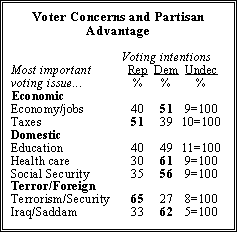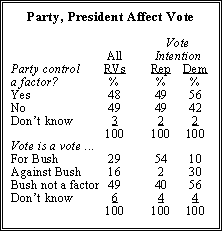Summary of Findings
As has been the case in recent elections, the popular vote for the House of Representatives is likely to be divided about equally between Republican and Democratic candidates, almost ensuring a narrow advantage for the party that controls the next Congress. The Pew Research Center’s final nationwide survey of 1,035 likely voters (1,610 registered voters) conducted Oct. 30-Nov. 2 finds 46% intending to vote Democratic, 44% Republican, with 10% undecided. This mirrors the closeness of the actual popular vote in the past two elections: Republican candidates garnered a one-point margin in 1998 and the popular vote was virtually even in 2000.

The correspondence between a party’s share of the popular vote and the number of seats it wins is too approximate to make a projection of which party will control the House when the popular vote is likely to be this close. The current two-point margin for the Democrats is not statistically significant and is identical to the final election survey of four years ago, when the GOP managed to hold on to its slim House advantage on Election Day.
The results of the new survey also represent no change when compared with the Center’s early October poll, which showed the Democrats with a 47%-46% edge. As seen in that poll, turnout indicators are about on par with what Center surveys found four years ago. The new survey did find 14% of the voter base in the sample had cast their ballots already, either by absentee ballot or one of the early voting procedures allowed by some states. Early voters said they voted for Democratic House candidates over Republicans by a 51%-41% margin.
As in most elections, the pool of likely voters is somewhat more disposed to GOP candidates than are all registered voters, but the gap is smaller than it was in 1998. Obviously, the current poll’s results cannot account for the get-out-the-vote efforts of the two parties over the final three days of the campaign. In that regard, a third of the 1,610 registered voters questioned said that already they had been contacted by one or more partisan or interest group efforts: 20% heard from Democratic organizations and 19% from Republicans.
Voting intentions in the poll follow patterns that have been apparent in recent national elections. The GOP will likely carry the male vote, while Democrats will probably win among women. Fully 85% of non-whites say they will vote Democratic, a figure that rises to 91% among African Americans. Voters below the age of 50 years will divide their vote about equally between the two parties. Those age 50-64 lean Democratic, while voters age 65 and older split about equally. Regionally, the Democrats are likely to win the popular vote in the East and Midwest, while the GOP leads in the South and West. In general, Republicans and Democrats will be about equally loyal to their party’s candidates.

Domestic Issues, Economy Top
Despite the narrow margin in the generic ballot, most voters point to traditional Democratic issues domestic concerns and the economy as the key factors in determining their vote. Asked to identify the most important issues, 44% of voters volunteered domestic issues notably education and health care while 40% named the economy. Only about one-in-five (19%) mentioned terrorism, Iraq or other foreign policy issues.
Democrats have a huge edge among voters who cite major domestic issues. Six-in-ten voters (61%) who mention health care as the most important factor in their vote intend to vote Democratic, compared with just three-in-ten who say they will vote Republican. Democrats hold a similar advantage among those who cite Social Security, while voters who name education as the issue favor Democrats 49%-40%.
There is a parallel split among the smaller pool of voters who cite national security and foreign policy as decisive factors in their vote. Nearly two-thirds (65%) of voters who cite terrorism or generally cite foreign policy intend to vote Republican. But nearly as many of those who specifically mention Iraq as a top issue (62%) support the Democrat in the generic ballot.

But voters who mention the economy as a decisive factor tend to divide fairly evenly along partisan lines. That is consistent with Pew Research Center surveys since early September showing neither party with a clear advantage in being seen as better able to handle the economy (see “Support For Potential Military Action Slips to 55%,” Oct. 30, 2002). Democrats are favored (51%-40%) among those who point to general economic concerns or jobs, while Republicans hold a comparable edge among voters who cite taxes as the top issue.
But Local Concerns Dominate
Yet for all of the attention to broad national issues, a 38% plurality says that state and local concern will make the biggest difference in who they vote for on Nov. 5. That is unchanged from the two most recent midterm elections: in the final stages of the 1998 campaign, 39% pointed to state and local issues as making the biggest difference in their vote, while 38% said that in early November 1994.
Roughly a quarter of voters (26%) cite the traits of the individual candidates their character and experience as making the biggest difference, while nearly as many (23%) cite national issues. Again, this is in line with trends from recent midterm campaigns.
Lower Marks for Terrorism Effort
The public has grown somewhat more critical of the government’s efforts to combat terrorism. While 69% say the government is doing at least fairly well in this struggle (15% very well, 54% fairly well), that is a decline from 83% a year ago. And the proportion who give the government negative marks for its anti-terrorism campaign has climbed steadily from 13% in early November 2001 to 27% today.
At the same time, an increasing number of Americans expect the economy to improve in the coming year. A 46% plurality believes the economy will be better off a year from now, while 31% expect it to remain the same and 17% expect economic conditions to worsen. In early October, 37% of the public said they anticipated the economy would improve, while 39% said it would stay the same and 18% thought it would get worse.
Democrats Consider Party Balance

Among those who intend vote Democratic, a 56% majority says that the issue of which party controls Congress is a factor in their vote. By comparison, party control is cited as a factor by 49% of Republican voters. The salience of this issue has grown among voters on both sides since early October, when 49% of Democratic voters and just 39% of Republican voters said they would consider the partisan balance in Congress when they voted.
Republican voters continue to say their congressional vote is a vote in support of the president nearly six-in-ten (54%) say this is the case. In 1998, just a third (35%) of Democratic voters considered their midterm vote to be a vote for President Clinton.
Most Democratic voters (56%) say Bush is not a factor in their vote, while three-in-ten consider their vote to be a vote against the president. This is consistent with the 1998 midterms, when 36% of Republican voters said their vote was in opposition to Bill Clinton.
Just one-in-ten voters (11%) say this Congress has accomplished more than other recent Congresses. More than twice as many (27%) think it has underachieved, while the majority (54%) say its productivity has been about the same as in previous years. Those who say Congress has done well favor Republican candidates by nearly two-to-one (59% vs. 31% who plan to vote Democratic). Those who think Congress has performed poorly favor the Democrats by a 50% to 39% margin.

Competitive Districts
The level of voter outreach has been particularly high in competitive districts, where fully 42% of registered voters and 58% of likely voters report that they have been contacted by a candidate, campaign or other group.
Voters in competitive districts are noticing what they see as a particularly high level of negative campaigning. Fully six-in-ten voters in competitive districts say there is more mudslinging and negative campaigning this year, compared with fewer than half of voters in races where one candidate has what appears to be a secure lead.